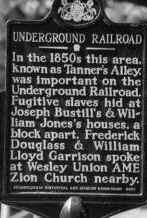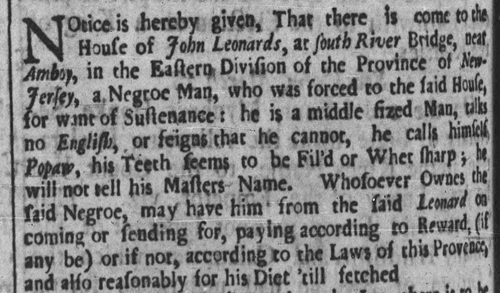
Study Areas
1726: Popaw is Found Starving, Speaks no English

NOtice is hereby given, That there is come to the House of John Leonards, at South River Bridge, near Amboy, in the Eastern Division of the Province of New-Jersey, a Negroe Man, who was forced to the said House, for want of Sustenance: he is a middle sized Man, talks no English, or feigns that he cannot, he calls himself Popaw, his Teeth seems to be Fil'd or Whet sharp; he will not tell his Masters Name. Whosoever Ownes the said Negroe, may have him from the said Leonard on coming or sending for, paying according to Reward, (if any be) or if not, according to the Laws of this Provence, also also reasonably for his Diet 'till fetched.
The advertisement above is a reminder that a large number of escaped slaves never succeeded in finding freedom. The moment an enslaved person stepped away from the plantation, farm, industry or residence of an enslaver with the intention of never returning, they faced a daunting challenge to survive. We often have a romanticized view of freedom seekers as courageous, clever people who relied on their wits and determination to evade pursuing enslavers and finally arrive at a safe harbor. In reality, however, many were quickly captured and returned to face often severe punishments. Others fell victim to the elements, became sick, got lost, were injured in the wilderness, or starved to death.
New Jersey farmer John Leonards provides few details about the man who called himself Popaw, who came to Leonards' rural farm in a desparate bid to stave off starvation. The only detail Leonards could learn from attempting to communicate with his unexpected visitor was his name. But he did notice Popaw's sharpened teeth and thought them odd enough to mention in his advertisement. Leonards seems to have been unaware of that body modification common in certain African cultures. That observation, and Popaw's inability to communicate in English, are clues that the man was probably only recently brought to the Americas in a slave ship.
Advertisements in Philadelphia newspapers of the time tell us that newly imported slaves sometimes escaped right from the ship or dock from which they were being offered for sale. Others escaped from new enslavers within days or weeks of being purchased. Unlike people that had been enslaved for years or born into enslavement, these men and woman were totally unfamiliar with the language, customs, geography and climate of the Middle Atlantic region, into which they had been involuntarily and brutally shipped.
And unlike people long enslaved in the region that escaped, whether after extensive planning or on sudden opportunity, these new arrivals lacked sufficient clothing, food, and even a rough idea of where to find aid. They simply knew that they had to escape an intolerable situation and the surrounding forest offered the best opportunity to hide.
Where Popaw came from is a mystery. Slave ships regularly landed at Perth Amboy during this time, and that seems to be a likely place, but the man could also have come from New York City, some thirty miles distant, or possibly even from Camden or Philadelphia, keeping to the heavily forested areas along the way, until hunger finally drove him, in desperation, to surrender to a white farmer.
Sources: The American Weekly Mercury (Philadelphia), 21 July 1726.
The Afrolumens Book: Covering the history of African Americans in central Pennsylvania from the colonial era through the Civil War.
Read it for free here: The Year of Jubilee, Volume One: Men of God, and Volume Two: Men of Muscle
Or Support the Afrolumens Project by Purchasing print copies on Amazon:



